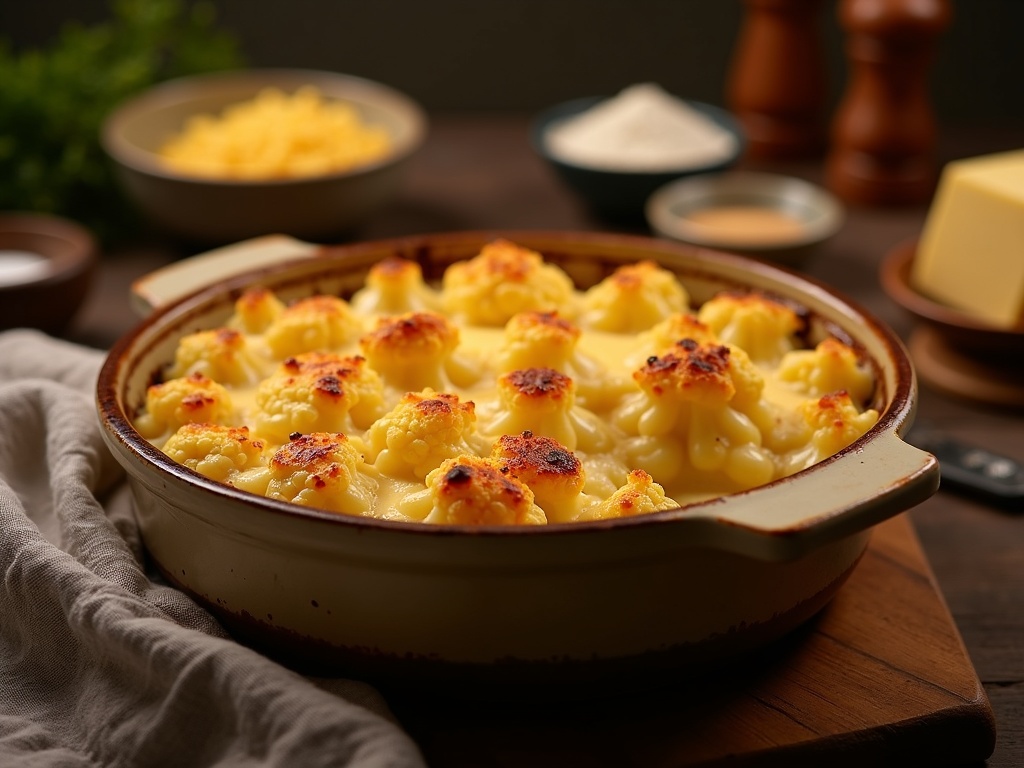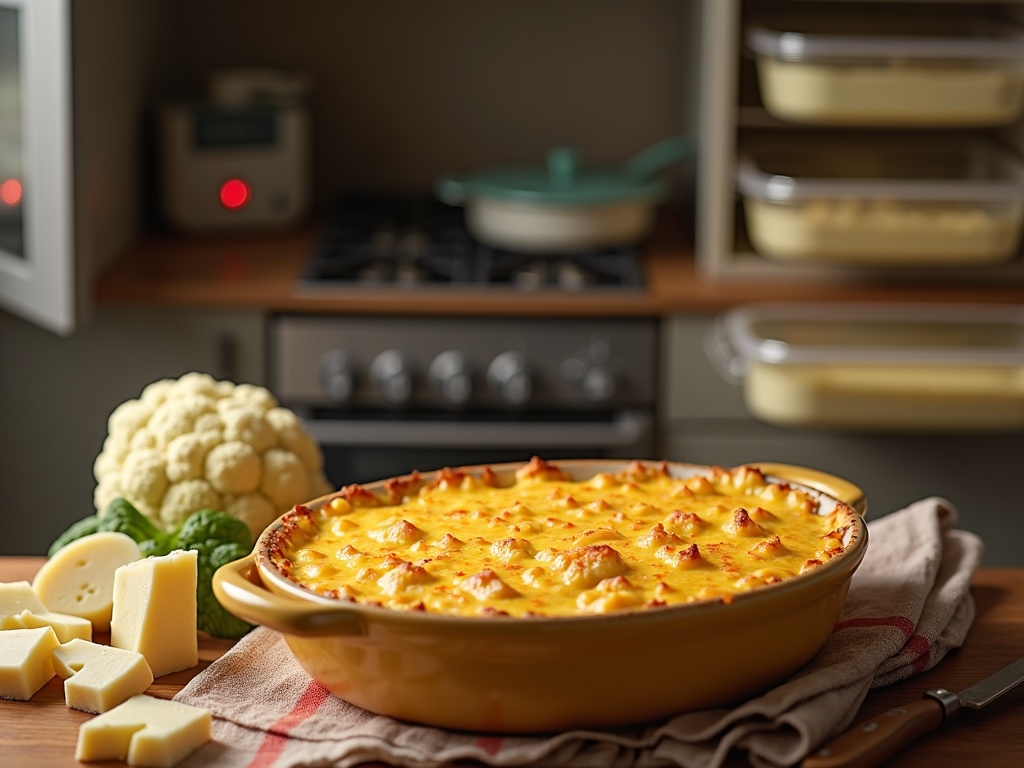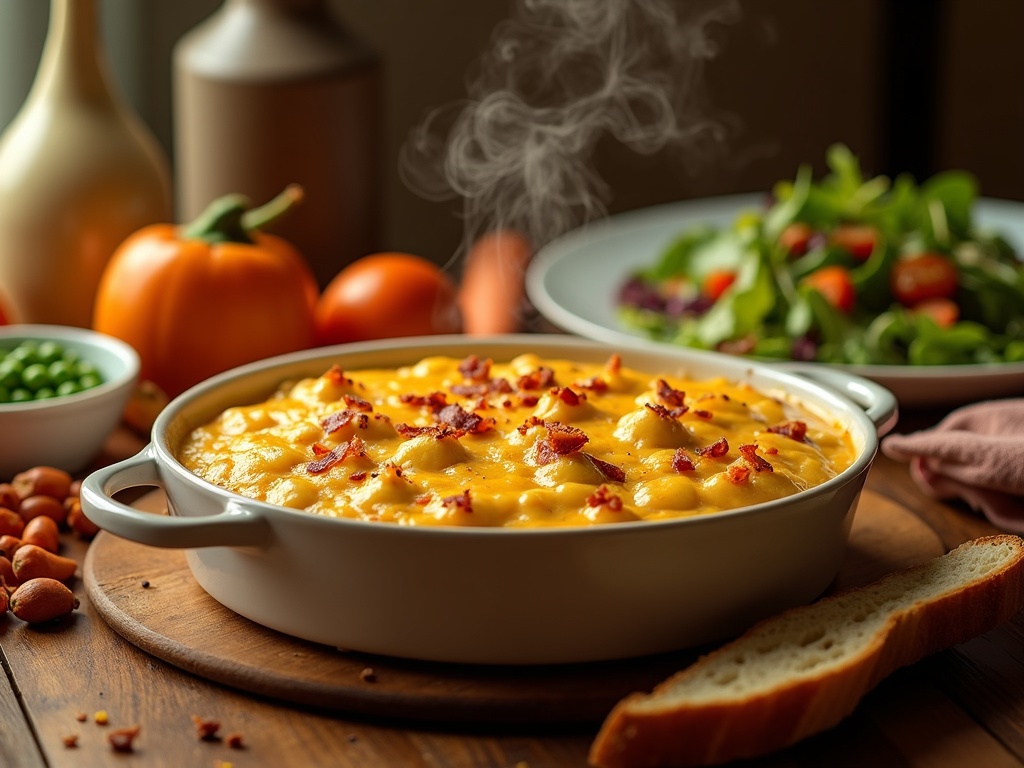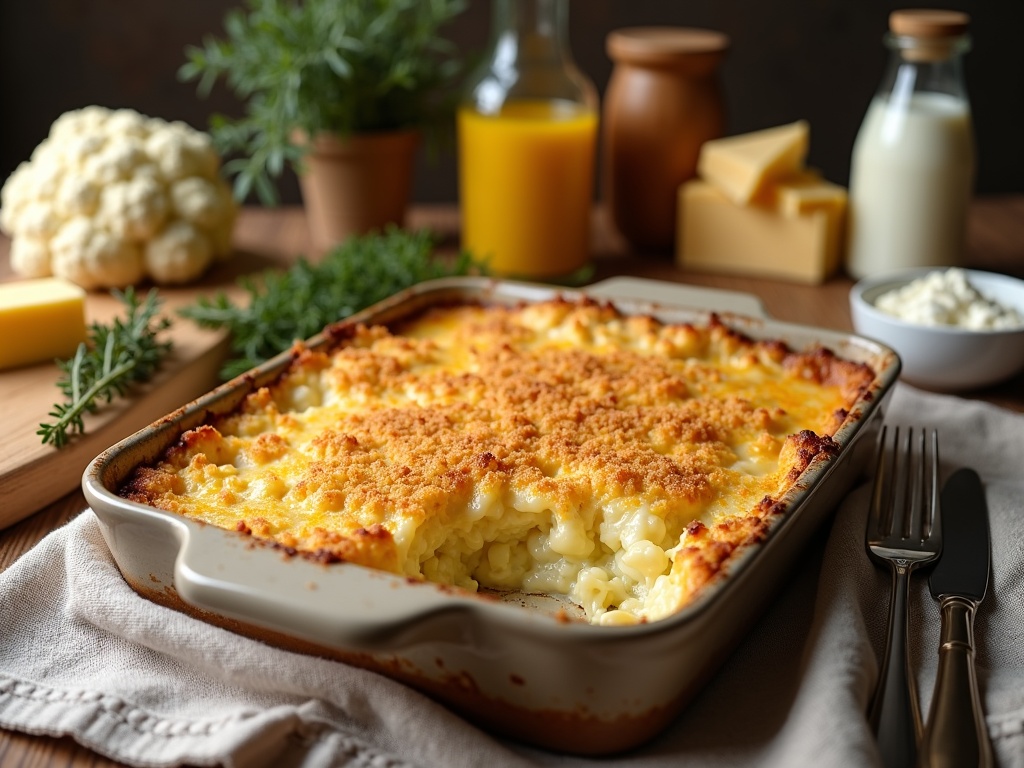The cauliflower cheese recipe transforms basic ingredients into a comforting British classic, balancing tender florets with arich, velvety cheese sauce. This versatile dish serves beautifully as either a satisfying vegetarian main or the perfect side for a Sunday roast, offering both culinary flexibility and practical convenience.
Find In This Article
Key Takeaways
- The dish requires simple ingredients including cauliflower, cheddar cheese, milk, butter, and flour for the béchamel base.
- Properly preparing the cauliflower to a tender-crisp stage before baking prevents mushiness in the final dish.
- Gradually adding room temperature milk to the roux while constantly whisking creates a smooth, lump-free sauce.
- Adding seasonings like nutmeg, mustard powder, and adequate salt enhances the flavor profile significantly.
- The dish can be made ahead, stores well for up to 3 days refrigerated, and can be frozen for up to a month.
What Makes This Dish Special
I’ve always found cauliflower cheese to be the ultimate comfort food – a British classic that never disappoints. The combination of tender cauliflower florets enveloped in a rich, creamy cheese sauce creates something truly magical on your plate. It’s simple food at its finest, yet the flavor profile is anything but basic.
Perfect for Any Occasion
This dish stands beautifully on its own as a vegetarian main course when you want something satisfying without meat. The substantial nature of the cheese sauce paired with the hearty cauliflower makes it filling enough to be the star of your meal. Alternatively, it works brilliantly as a side dish alongside savory chicken and mushroom pie or your Sunday roast.
What makes this recipe particularly special is its versatility. You can customize the cheese sauce with various additions – a bit of tangy blue cheese for depth, or perhaps some mustard for extra kick. The basic template allows for endless variations while maintaining that comforting core.
Practical Benefits
Beyond the delicious taste, this cauliflower cheese recipe offers several practical advantages:
- Ready in under 45 minutes from start to finish
- Uses simple ingredients most people already have in their kitchen
- Budget-friendly, especially when cauliflower is in season
- Easily scaled up to feed a crowd or down for a solo meal
- Leftovers reheat beautifully for next-day enjoyment
- Can be prepared ahead and baked when needed
The economical nature of this dish makes it perfect for feeding a family without breaking the bank. Cauliflower provides substantial nutrition while the creamy white sauce transforms it into something everyone eagerly devours.
I find the process of making cauliflower cheese almost as satisfying as eating it. There’s something therapeutic about watching a simple roux transform into a silky sauce, then seeing the dish emerge from the oven with that perfect golden crust on top. It’s this balance of simplicity and satisfaction that makes this dish a perpetual favorite in my kitchen rotation.
Ingredients You Will Need
Creating a delicious cauliflower cheese dish starts with gathering quality ingredients. I’ve perfected this recipe over time, focusing on the balance between creamy sauce and perfectly cooked cauliflower.
Core Ingredients
The foundation of a great cauliflower cheese begins with a large cauliflower head. I always look for one that’s firm, white, and free from brown spots. Once home, I cut it into medium-sized florets—not too small that they become mushy during baking, but not so large that they don’t cook through.
The cheese selection makes a substantial difference in the final flavor. I use 3 cups of mature cheddar cheese, freshly grated. Pre-packaged grated cheese often contains anti-caking agents that can affect the smoothness of your sauce. For extra depth, you could mix in some blue cheese for added flavor complexity.
For the béchamel base, you’ll need:
- 2 cups of whole milk (full-fat works best for richness)
- 4 tablespoons of butter (unsalted lets you control the seasoning)
- 4 tablespoons of all-purpose flour for thickening
- 1 teaspoon of mustard powder (adds tanginess without overwhelming)
- Salt and black pepper to taste
Optional Enhancements
While the classic recipe is magnificent on its own, I like to add a crunchy topping of breadcrumbs. This creates a delightful textural contrast against the creamy sauce. If you’re feeling adventurous, consider mixing the breadcrumbs with a bit of extra grated cheese or dried herbs before sprinkling.
For those who enjoy exploring flavor variations, consider these additions:
- A pinch of nutmeg to complement the béchamel
- A few sprigs of fresh thyme
- Half a teaspoon of English mustard instead of powder for more punch
- A dash of Worcestershire sauce for umami depth
The quality of your milk matters significantly in this recipe. I find that whole milk creates the most satisfying sauce, but if you’re watching calories, you can use 2% with only a slight compromise in creaminess. Just avoid skim milk as it produces a thinner sauce.
If you’re looking to experiment with cheese combinations, consider mixing the cheddar with Gruyère for nuttiness or Parmesan for sharpness. Whatever combination you choose, the key is to ensure your cheese melts well into a smooth sauce.
For those who enjoy making white sauce for pasta dishes, you’ll find the technique for cauliflower cheese sauce quite similar—it’s essentially a cheese-enriched béchamel that coats the cauliflower perfectly.
Temperature is crucial when working with these ingredients. I always bring the milk to room temperature before adding it to the roux (butter and flour mixture). This prevents the sauce from seizing and creates a silky-smooth consistency.
With these quality ingredients ready, you’re set to create a cauliflower cheese that strikes the perfect balance between comfort food indulgence and sophisticated flavor. The combination of tender cauliflower enrobed in rich, cheesy sauce is hard to beat for a satisfying side dish or vegetarian main.
How To Make The Perfect Cauliflower Cheese
I’ve mastered the art of making cauliflower cheese over years of kitchen experiments, and I’m excited to share my foolproof method. This classic dish combines tender cauliflower with a rich, velvety cheese sauce that’s hard to resist.
Step-by-Step Process
The first crucial step is preparing your cauliflower properly. I cut a medium-sized cauliflower into even florets and boil them in lightly salted water for 5-7 minutes. The key here is achieving that perfect tender-crisp texture – you want the cauliflower cooked through but still holding its shape. Test with a fork; it should pierce easily but not fall apart.
While the cauliflower drains well (excess water is the enemy of a good cheese sauce), I start on my sauce. This white sauce base begins with creating a roux:
- Melt 50g of butter in a saucepan over medium heat
- Add 50g of plain flour and stir continuously for 1-2 minutes until it forms a paste
- Gradually add 500ml of milk, pouring slowly while whisking constantly to prevent lumps
- Continue stirring until the sauce thickens enough to coat the back of a spoon
Once my sauce has thickened, I transform it by adding 200g of grated mature cheddar cheese. For extra depth, I sometimes mix in a little blue cheese for additional flavor. Season with salt, pepper, and a pinch of nutmeg to enhance the cheesy goodness.
The final assembly couldn’t be simpler. I place my drained cauliflower in an ovenproof dish, pour the cheese sauce over it, ensuring every floret gets covered, and top with a bit more grated cheese and perhaps some breadcrumbs for texture. Into a preheated 200°C oven it goes for 20-25 minutes until golden and bubbling.
This dish pairs wonderfully with a variety of meals, from roast chicken to vegetarian feasts. You can also customize it by adding extras like crispy bacon bits, sautéed mushrooms, or even some chili flakes for heat.
Common Mistakes To Watch For
When making cauliflower cheese, even small errors can impact the final dish. I’ve encountered several pitfalls that can turn this comforting classic into a disappointing dinner. Awareness of these common mistakes will help you create a perfectly creamy, flavorful cauliflower cheese every time.
Texture and Preparation Errors
Overcooking the cauliflower before it goes into the oven is perhaps the most frequent mistake I see. The cauliflower should be parboiled just until fork-tender—about 5 minutes is usually sufficient. If you cook it completely before baking, you’ll end up with a mushy, waterlogged dish. Remember that the cauliflower will continue to cook while baking in the cheese sauce. I aim for a slight resistance when piercing with a fork during the initial cooking stage.
Another texture issue comes from using pre-grated cheese. While it seems convenient, pre-grated cheese contains anti-caking agents that affect how it melts. These additives can make your sauce grainy instead of silky smooth. I always recommend grating your own cheese from a block for the best cheese sauce consistency. Freshly grated cheese melts more evenly and creates that gorgeous, glossy texture we’re after.
Sauce Preparation Missteps
The cheese sauce is the crown jewel of this dish, and several mistakes can occur during its preparation. A common error is adding all the milk at once to the roux (butter and flour mixture). This often leads to lumps that are difficult to remove. Instead, I add milk gradually while whisking constantly. This method creates a velvety white sauce base that incorporates easily with the cheese.
Inadequate seasoning is another frequent oversight. Cauliflower has a mild flavor, and cheese sauce needs proper seasoning to bring the dish alive. Here are key seasoning considerations:
- Salt and pepper should be added to both the cauliflower cooking water and the cheese sauce
- A pinch of nutmeg enhances the flavor of the béchamel without overpowering
- A small amount of mustard (about 1 teaspoon) complements the cheese beautifully
- Taste your sauce before adding the cauliflower and adjust seasonings accordingly
Not allowing enough time for the sauce to thicken is also problematic. I simmer the sauce for at least 3-5 minutes after adding the milk to ensure the flour has cooked out completely. This patience prevents that raw flour taste that can ruin an otherwise perfect dish.
Rushing the final browning stage is tempting when you’re hungry, but allowing your comforting baked dish enough time under the broiler creates that irresistible golden crust that adds textural contrast. Just a few minutes makes all the difference between bland and brilliant.
By avoiding these common mistakes, your cauliflower cheese will have the perfect balance of tender-yet-firm cauliflower enrobed in a silky, flavorful cheese sauce, topped with a golden, bubbling crust. This attention to detail transforms a simple dish into something truly special that your family or guests will rave about.

Pro Tips For Best Results
I’ve made cauliflower cheese countless times over the years, and I’ve picked up several techniques that transform this dish from good to exceptional. These small adjustments make a significant difference in the final result without adding much extra effort.
Perfecting Your Preparation
Always pat your cauliflower dry after boiling or steaming it. This simple step prevents excess moisture from diluting your cheese sauce. I use paper towels or a clean kitchen cloth to gently press the florets and remove as much water as possible. This ensures the sauce coats the cauliflower properly instead of sliding off or becoming watery at the bottom of your dish.
Room temperature milk is a game-changer when making your white sauce. I take the milk out of the fridge about 30 minutes before starting. Cold milk can cause the sauce to seize or develop lumps, while room temperature milk incorporates smoothly into your roux. This creates a silky texture that’s much harder to achieve with cold ingredients.
Freshly grated cheese melts dramatically better than pre-shredded options. Pre-packaged shredded cheese often contains anti-caking agents that can leave your sauce slightly grainy. I grab a block of quality cheddar and grate it myself just before adding it to the sauce. The difference is noticeable in how evenly it melts and the smooth, velvety finish of the final dish.
Flavor Enhancements
A pinch of freshly grated nutmeg adds incredible depth to your creamy white sauce without overpowering the dish. This subtle spice works harmoniously with cheese and cauliflower, creating a more complex flavor profile that guests will notice but might not be able to identify. I use just enough to enhance without dominating—about ⅛ teaspoon for a family-sized dish.
Patience pays off when making cauliflower cheese. After removing it from the oven, let it rest for 5 minutes before serving. During this time, the sauce slightly thickens and the flavors settle together. This brief resting period also makes portioning easier as the dish won’t immediately collapse when served.
I’ve found these additional tips helpful for an outstanding finish:
- Season each component separately—salt the water for the cauliflower and properly season the sauce
- Don’t overcook the cauliflower before baking—aim for tender-crisp to prevent mushiness
- For a golden top, finish under the broiler for 2-3 minutes but watch carefully to prevent burning
- Consider adding a tablespoon of Dijon mustard to the sauce for a gentle tang that complements the cheese sauce beautifully
- Mix up your cheese selection—mature cheddar provides depth while Gruyère adds nutty notes
The finishing touches make all the difference. I sometimes add a light sprinkle of smoked paprika on top before serving, or a few fresh thyme leaves for color and aroma. These final details elevate the presentation and add subtle flavor nuances.
When serving, pair your cauliflower cheese with a simple green salad dressed with lemon juice to cut through the richness. The acidity provides perfect balance against the creamy, cheesy goodness of this comfort food classic.
I often prepare extra savory dishes alongside my cauliflower cheese to create a complete meal that satisfies everyone at the table.

Storage And Reheating
I’ve found that proper storage and reheating techniques can make or break your cauliflower cheese experience. This rich, creamy dish can be enjoyed for days after preparation if handled correctly, making it a perfect option for meal prep.
Refrigeration Guidelines
Cauliflower cheese keeps beautifully in the refrigerator for up to 3 days. Once cooled, I transfer it to an airtight container to prevent it from absorbing other flavors in the fridge. The cheese sauce will thicken considerably when chilled, which is completely normal. For best results, I let the dish cool completely before refrigerating to prevent condensation that could make the top soggy. If you’re making a larger batch, similar to a creamy white sauce pasta, the same storage principles apply.
When preparing the dish for storage, I cover it with cling film, pressing it directly onto the surface of the cheese sauce. This prevents a skin from forming and helps maintain the smooth texture when reheated.
Reheating For Best Results
The oven is unquestionably the best method for reheating cauliflower cheese, as it helps maintain the dish’s texture and prevents the sauce from separating. I preheat my oven to 350°F (175°C) and cover the dish with foil to prevent it from drying out or burning on top. Depending on the portion size, it typically takes 15-20 minutes to heat through.
For an extra touch of freshness, I add a light sprinkle of freshly grated cheese on top before reheating. This creates a new, golden crust similar to what you’d find in a chicken and mushroom pie with its perfectly melted cheese topping.
The microwave can work in a pinch, but be careful as it often leads to uneven heating and can make the sauce split. If using the microwave, I heat the dish in 30-second intervals, stirring between each to distribute the heat evenly.
Freezing Options
Cauliflower cheese freezes surprisingly well for up to 1 month. Here’s my approach for freezing:
- Allow the dish to cool completely before freezing
- Portion into freezer-safe containers for easier defrosting
- Label with the date to track freshness
- Leave some space at the top of containers for expansion
- Wrap well to prevent freezer burn
When ready to use the frozen cauliflower cheese, I thaw it overnight in the refrigerator before reheating. This gradual thawing helps preserve the texture of both the cauliflower and the sauce.
During reheating of previously frozen portions, I’ve found that adding a splash of milk helps revive the sauce if it seems dry or has separated. Just like when making blue cheese sauce, the extra liquid helps bring everything back together.
For the best taste after freezing, I always add a layer of fresh cheese on top before the final reheating. This simple addition makes the dish taste almost freshly made, with that desirable golden, bubbling cheese top that makes cauliflower cheese so appealing.

Serving Suggestions
There’s something truly magical about a bubbling dish of cauliflower cheese coming out of the oven. Once you’ve prepared this golden, creamy delight, you’ll want to make sure you serve it in ways that maximize its deliciousness. I’ve found several perfect pairings that take this classic comfort food to new heights.
Main Meal Accompaniments
A slice of crusty bread is arguably the perfect companion to cauliflower cheese. The bread’s crunchy exterior and soft interior create a delightful textural contrast to the creamy sauce. I love using it to mop up any remaining cheese sauce – it’s too good to waste!
Cauliflower cheese also makes an exceptional side dish for a traditional roast dinner. The cheesy goodness complements roast chicken or beef beautifully, adding a rich element to the meal. It’s particularly fantastic alongside savory chicken dishes where the creamy texture balances heartier elements.
For a complete meal, I recommend serving with steamed vegetables on the side. Bright green peas, tender carrots, or even some seasonal vegetables add color and nutritional balance to your plate. This combination creates a satisfying meal that’s both comforting and wholesome.
Creative Enhancements
Want to take your cauliflower cheese up a notch? Try adding crispy bacon bits on top just before serving. The salty, crunchy bacon provides a fantastic flavor contrast to the smooth, creamy sauce. This simple addition transforms the dish from a side into something that could easily take center stage at your dinner table.
For those who enjoy a bit of heat, a sprinkle of chili flakes adds a warming kick that cuts through the richness of the cheese. You could also experiment with different cheese combinations to customize the flavor profile to your preference.
Cauliflower cheese also pairs wonderfully with acidic elements that balance its richness. Consider serving with a simple side salad dressed with a tangy vinaigrette or adding a spoonful of chutney on the plate. These acidic notes help cut through the richness and create a more balanced eating experience.


